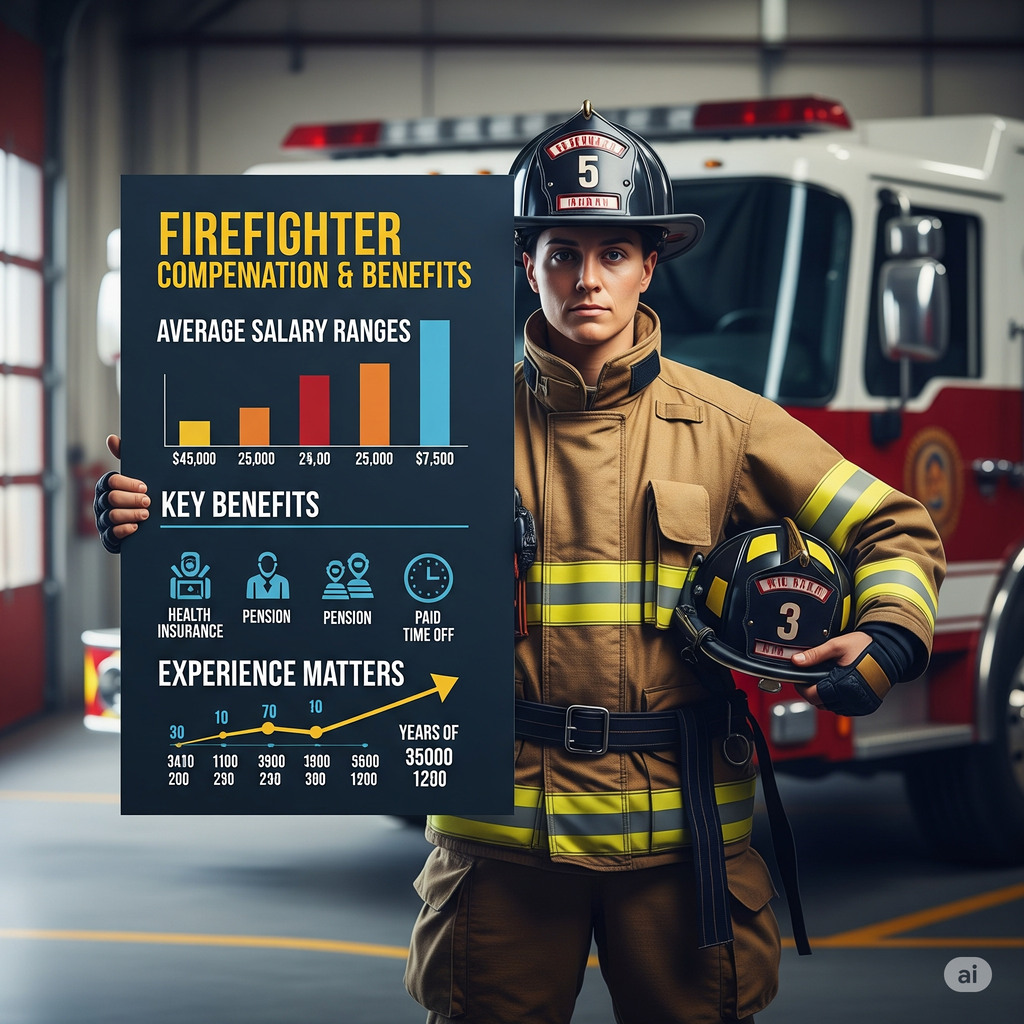
Firefighting is a courageous profession that requires intense physical conditioning, technical skills, and mental fortitude. Firefighters don’t just extinguish blazes—they respond to medical emergencies, rescue trapped victims, mitigate hazardous material spills, and often serve as the first line of defense during natural disasters.
Given the high-risk nature of the job, many wonder: How much do firefighters actually earn in the U.S.? The answer varies widely by state, city, experience level, and department funding. In this guide, we break down average firefighter salaries across the country, factors affecting pay, benefits, and provide a detailed state-by-state salary chart.
Average Firefighter Salary in the U.S.
As of the latest data from the U.S. Bureau of Labor Statistics (BLS, 2024), the average annual salary for firefighters is approximately $56,310. However, salaries range from under $35,000 for entry-level or rural positions to well over $100,000 in top-paying metro areas or specialized roles like fire captains or engineers.
| Job Role | Average Salary (USD/year) |
|---|---|
| Firefighter (entry-level) | $36,000 – $45,000 |
| Mid-level Firefighter | $50,000 – $70,000 |
| Fire Captain | $70,000 – $100,000+ |
| Fire Chief | $90,000 – $150,000+ |
Key Factors Affecting Firefighter Salaries
1. Location
Firefighters in large cities like San Francisco or New York tend to earn more due to higher living costs and union-negotiated wages. Conversely, rural areas may pay substantially less.
2. Experience & Rank
Rank significantly affects pay. A fire captain, battalion chief, or chief earns much more than an entry-level firefighter. Promotions come with higher responsibilities and compensation.
3. Overtime and Shift Pay
Many firefighters work 24-hour shifts followed by 48-72 hours off. Overtime, holiday pay, and emergency calls can considerably increase total income.
4. Union Representation
Firefighter unions such as the International Association of Fire Fighters (IAFF) often negotiate wages, benefits, and safety standards, especially in unionized cities and states.
5. Department Type
Salaries can differ based on whether the department is municipal, state-run, federal (e.g., wildland firefighters), or volunteer (who may receive a stipend or none at all).
Benefits Beyond Salary
Firefighters typically receive generous benefits packages, including:
- Pension and retirement plans
- Health, dental, and vision insurance
- Paid leave and holidays
- Disability and life insurance
- Education and training stipends
In many areas, firefighters can retire as early as age 50 with a pension, depending on years of service and department policy.
USA Firefighter Salary Chart by State (2024)
Below is a chart showcasing the average annual salary for firefighters by U.S. state, based on BLS and state-level fire department data:
| State | Average Annual Salary |
|---|---|
| California | $88,750 |
| New Jersey | $86,880 |
| Washington | $80,320 |
| New York | $79,820 |
| Nevada | $78,490 |
| Oregon | $75,150 |
| Connecticut | $74,190 |
| Illinois | $72,380 |
| Alaska | $71,850 |
| Massachusetts | $70,410 |
| Texas | $56,810 |
| Florida | $52,240 |
| Georgia | $47,390 |
| North Carolina | $44,580 |
| Ohio | $48,930 |
| Pennsylvania | $50,180 |
| Michigan | $50,990 |
| Arizona | $54,610 |
| Colorado | $62,470 |
| Minnesota | $58,970 |
| Indiana | $49,750 |
| Wisconsin | $51,870 |
| Missouri | $47,290 |
| Alabama | $45,690 |
| Tennessee | $44,760 |
| South Carolina | $44,320 |
| Kentucky | $43,510 |
| Louisiana | $42,980 |
| Oklahoma | $44,870 |
| Iowa | $48,100 |
| Arkansas | $41,250 |
| Mississippi | $39,820 |
| New Mexico | $43,720 |
| Nebraska | $46,550 |
| Kansas | $45,610 |
| Utah | $52,100 |
| Idaho | $50,270 |
| Maine | $49,080 |
| Vermont | $50,950 |
| New Hampshire | $52,710 |
| Rhode Island | $66,590 |
| Delaware | $59,130 |
| West Virginia | $41,860 |
| North Dakota | $47,820 |
| South Dakota | $43,420 |
| Montana | $44,050 |
| Wyoming | $47,390 |
| Hawaii | $63,920 |
Note: These are average base salaries. Total compensation may be significantly higher when accounting for overtime, bonuses, and benefits.
Top-Paying Cities for Firefighters
Cities where firefighters earn the most often align with high living costs. Here are some of the highest-paying metro areas:
| City | Average Salary |
|---|---|
| San Jose, CA | $121,000 |
| San Francisco, CA | $115,820 |
| Oakland, CA | $112,320 |
| Seattle, WA | $101,920 |
| New York City, NY | $97,380 |
| Los Angeles, CA | $95,440 |
| Boston, MA | $89,780 |
| Denver, CO | $86,920 |
Volunteer Firefighter Compensation
Roughly two-thirds of U.S. fire departments are staffed by volunteers. While most do not receive traditional salaries, many are compensated through:
- Per-call stipends
- Training allowances
- Property tax breaks
- Pension-like Length of Service Award Programs (LOSAP)
States like Pennsylvania, Texas, and New York have large volunteer firefighter populations.
Firefighter Career Outlook
Firefighting remains a competitive field due to its job security, benefits, and community impact. According to the BLS, employment for firefighters is projected to grow 4% from 2022 to 2032, about as fast as the average for all occupations.
Firefighter job growth is driven by:
- Urban population increases
- Climate change (more wildfires)
- Infrastructure growth
- Expanded EMT/paramedic responsibilities
Tips to Maximize Earnings as a Firefighter
- Earn Advanced Certifications: EMT-P (Paramedic), HazMat, Technical Rescue, and Fire Instructor credentials boost pay potential.
- Apply in High-Paying States/Cities: If mobility allows, target areas like California, New York, or Washington.
- Advance in Rank: Work toward positions like Engineer, Lieutenant, Captain, or Chief.
- Take Overtime Shifts: Many departments offer additional pay for working holidays or extra shifts.
- Consider Federal Wildland Firefighting: Agencies like the U.S. Forest Service and Bureau of Land Management offer competitive seasonal pay and training.
Conclusion
Firefighting is more than just a job—it’s a calling rooted in public service, heroism, and resilience. While pay can vary significantly by location and role, most full-time firefighters earn solid middle-class wages with excellent benefits. Those who rise through the ranks or serve in high-demand metro areas can earn six figures or more.
Whether you’re a future recruit or just curious about the numbers behind the badge, understanding firefighter salaries reveals just how valuable these first responders are—and how states value their critical service differently.
